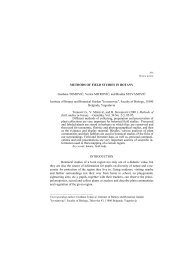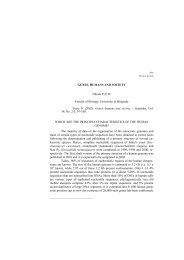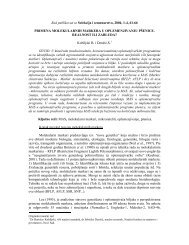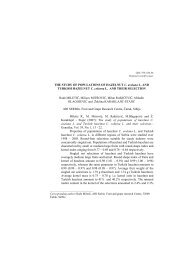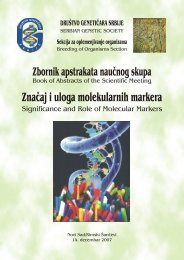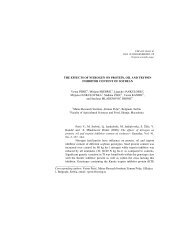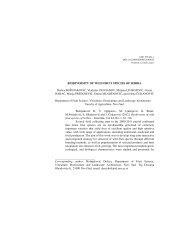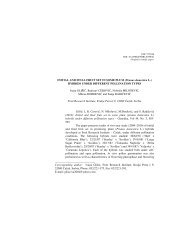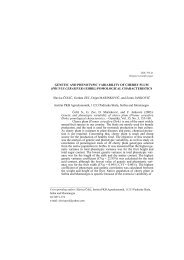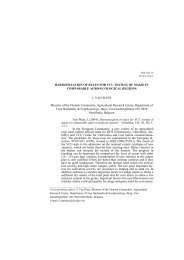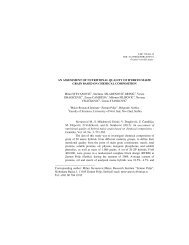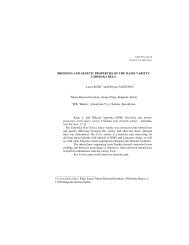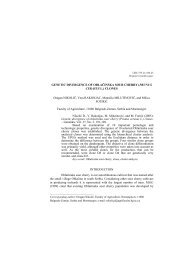Zbornik - Društvo genetičara Srbije
Zbornik - Društvo genetičara Srbije
Zbornik - Društvo genetičara Srbije
Create successful ePaper yourself
Turn your PDF publications into a flip-book with our unique Google optimized e-Paper software.
V-Usm-12 ZBORNIK ABSTRAKATA III KONGRESA GENETIÈARA SRBIJE 195<br />
Subotica, 30. novembar - 4. decembar 2004.<br />
EVALUACIJA CITOTOKSIÈNIH I GENOTOKSIÈKIH EFEKATA<br />
ESTRADIOLA PRIMENOM IN VITRO MIKRONUKLEUS TESTA<br />
N. Ðeliæ 1 , Biljana Spremo-Potpareviæ 2 , Dijana Ðeliæ 3 i V. Bajiæ 4<br />
1<br />
Katedra za biologiju, Fakultet veterinarske medicine, Univerzitet u Beogradu, Beograd<br />
2<br />
Institut za fiziologiju, Farmaceutski fakultet, Univerzitet u Beogradu, Beograd<br />
3<br />
Katedra za anatomiju, Fakultet veterinarske medicine, Univerzitet u Beogradu, Beograd<br />
4<br />
Institut za biomedicinska istraivanja «Galenka», Beograd<br />
Hormoni predstavljaju jedan od glavnih faktora rizika za nastanak malignih oboljenja,<br />
naroèito u organima pod snanim uticajem hormona (dojka, endometrijum, prostata).<br />
Najbolje prouèena grupa hormona su seksualni steroidi, posebno estrogeni. Pokazano je<br />
da prirodni i sintetièki, steroidni i nesteroidni estrogeni mogu da ostvare stimulaciju<br />
mitotièkih deoba delujuæi na taj naèin kao tumor-promotori. Meðutim, sve je više<br />
podataka da estrogeni mogu da deluju i na nivou inicijacije kancerogeneze. Naime, pri<br />
metabolièkoj transformaciji estrogena u æeliji dolazi do stvaranja oksidativnog stresa<br />
praæenog ošteæenjima molekula DNK, ukljuèujuæi kovalentne modifikacije azotnih baza.<br />
Praæen je širok spektar koncentracija estradiola, ukljuèujuæi koncentracije koje<br />
odgovaraju terapijskim dozama u humanoj medicini, kao i znatno veæe koncentracije od<br />
terapijskih. In vitro mikronukleus test uraðen je po odgovarajuæim smernicama OECD-a<br />
o testiranju na genotoksiènost. Korišæena je periferna venska krv tri zdrave muške osobe<br />
mlaðe od 35 godina. Za statistièku analizu upotreljen je Studentov t-test.<br />
Dobijeni rezultati ukazuju da tek pri koncentracijama 30 i 100 puta veæim od<br />
maksimalnih terapijskih doza u humanoj medicini estradiol znaèajno poveæava uèestalost<br />
mikronukleusa. Prema tome, rizik od izraenih genotoksiènih efekata estradiola postoji u<br />
sluèaju predoziranja estradiola i, verovatno, pri dugotrajnoj terapiji. Pored toga ove dve<br />
najviše ispitivane koncentracije dovele su do usporavanja progresije kroz æelijski ciklus i<br />
do smanjenja procenta binukleisanih limfocita verovatno usled citotoksiènih efekata.<br />
EVALUATION OF CYTOTOXIC AND GENOTOXIC EFFECTS OF<br />
OESTRADIOL IN CYTOKINESIS BLOCK MICRONUCLEUS ASSAY<br />
Hormones can be considered as the major risk factor for the development of cancer, especially<br />
in organs under strong hormonal influence (breast, endometrium, prostate). The<br />
best studied group of hormones are sexual steroids, especially oestrogens. It has been revealed<br />
that oestrogens (natural and synthetic, steroidal and nonsteroidal) can stimulate<br />
mitotic divisions and, therefore, act as tumor promoters. However, there is increasing evidence<br />
of the genotoxic effects of oestrogens (tumor initiation). According to the modern<br />
standpoint, metabolic conversion (redox cycling) of oestrogens leads to oxidative stress<br />
and DNA damage, including formation of DNA adducts.<br />
We examined a wide range of oestradiol concentrations, including those corresponding<br />
therapeutic doses in human medicine, as well as much higher concentrations. In vitro<br />
micronucleus assay was performed according to the standard genotoxicity OECD guidelines.<br />
Peripheral venous blood from three healthy men younger than 35 was used in these<br />
experiments. Statistical analysis was performed by Student´s t-test.<br />
The obtained results showed that only the concentrations of 30 and 100 fold maximal<br />
therapeutic doses have caused a significant increase of micronucleus frequency. Therefore,<br />
there is some genetic risk if oestradiol is overdosed and, possibly, after a long term<br />
therapy. In addition, the two highest concentrations caused cell cycle delay and decrease<br />
of binucleated lymphocytes which probably resulted from cytotoxic effects.



